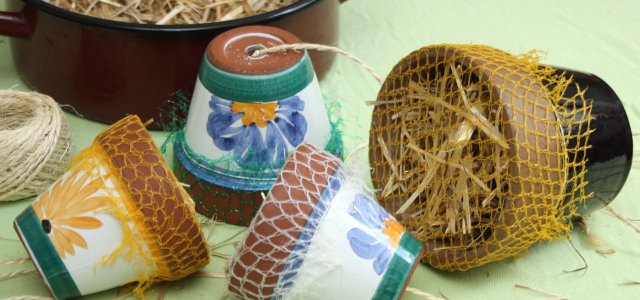
With a homemade earwig house you offer the useful insects a protected place in your garden. The earwigs thank you by eating the aphids from your plants.
An earwig house is not only very useful, but also a very decorative element in the garden. Pests can undo all the hard work you’ve put into your garden in a short period of time. Aphids in particular are a problem in the garden when natural predators – earwigs and ladybugs – are absent. In your self-built earwig house, you not only offer the earwigs a shelter, but also a certain security from their own enemies, the birds. This allows the earwigs to multiply in the garden and at the same time reduces the aphids in the garden.
Contents
Building earwig house: The material
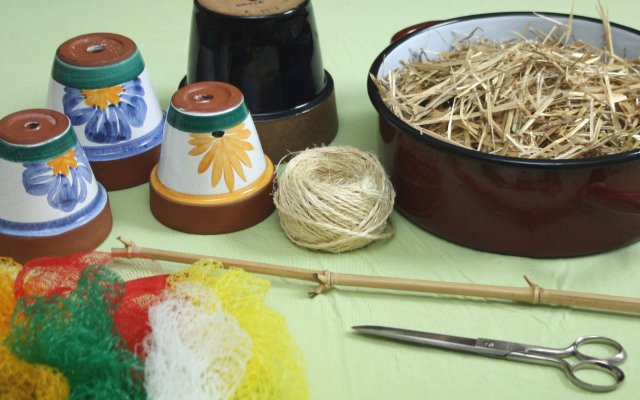
You don’t have to buy anything new to build an earwig house. You will have most of the material in your household if you have a garden.
This is the material you will need for a homemade earwig house:
- clay flower pots with a hole in the bottom
- a thin string and a needle
- vegetable or fruit nets
- a pair of scissors
- a sturdy string e.g. of hemp or sisal
- small pieces of wood or some bamboo
- wood wool or straw
Tip: Put an old sheet or newspaper underneath when you make the earwig house. This will allow you to quickly clean up the debris from the straw.
Building an earwig house: The first steps
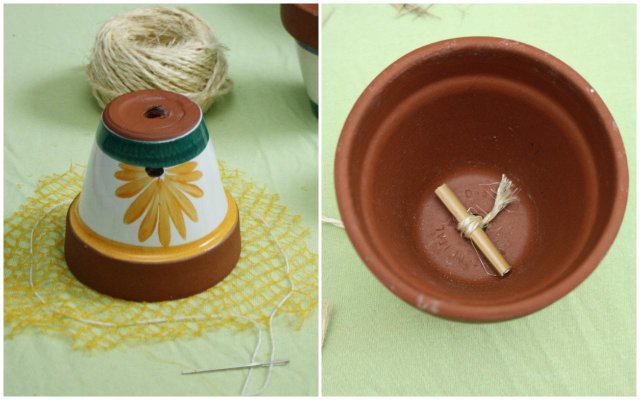
Build an earwig house from an old flower pot is quite simple. Such an earwig hiding place is not only useful, but can also be very pretty. If you don’t have glazed flower pots, you can also design the clay pot yourself with acrylic paints.
Here’s how to build the earwig house:
- Cut the vegetable net and spread it out on the base.
- Place the pot on the vegetable net and cut around it with a distance of about four to five centimeters.
- With the help of the needle, pull a thread into the vegetable net at a distance of about 2 centimeters from the edge (see picture on the left). With this thread you will later fix the vegetable net to the clay pot.
- Cut the piece of wood to the appropriate length (diameter of the lower pot).
- Wrap the string with which you want to hang the earwig house around the piece of wood and knot it.
- Pull the string through the hole in the bottom of the clay pot (see picture on the right).
To fill the earwig house

Now you can fill the earwig house:
- Stuff some wood wool or straw into the clay pot.
- Place the prepared vegetable net on the opening (see picture on the left).
- Pull the thin string tightly around the edge of the clay pot and knot the ends (see picture on the right).
- Cut off the protruding thread.
To build an earwig hiding place you only need about ten minutes. However, the beneficial insects will enjoy it for a long time and you will be rewarded by your plants having much fewer problems with aphids.
Protection from birds
The natural enemy of earwigs is birds. The straw in earwig houses is good nesting material for birds. For this reason, it is important that you close the earwig hotel with a net. The netting not only prevents birds from getting the straw from the potties, but also prevents them from reaching and eating the insects in the earwig house with their beaks.
Seal the earwig house
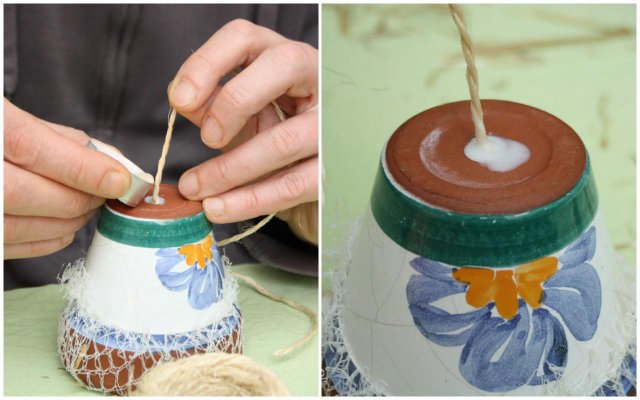
To keep the earwigs dry in their earwig hotel, you can seal the hole in the clay pot with wax. But this does not have to be done.
- Light a candle. Stick candles are particularly suitable for this. But even with a small tea light you can close the hole.
- Let some wax drip into the hole next to the string.
- The wax must cool down before you let more wax drip into the hole.
- Repeat the process until the hole is closed.
To place the earwig house in the garden
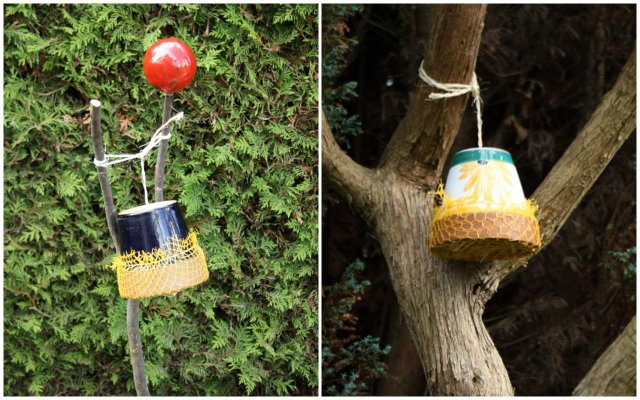
With your self-made earwig hotel you contribute to earwigs settling in your trees. In order for the earwigs to accept the shelter, you should set up the earwig house early in the spring near the typical overwintering quarters (piles of brushwood or leaves) with the opening facing downwards. Hang your earwig hiding place on the tree with the opening facing downwards from mid-June.
Important: Make sure all pots are in direct contact with the trunk or a large branch so earwigs can reach their lair without detours. Earwigs, which are native to our region, are largely flightless and prefer to travel on foot.
The plants that are particularly infested with lice do not always grow near trees. In that case, stick a wooden stick into the ground next to the plants and attach the earwig hotel to it (picture left).
Upcycling earwig house build yourself
A very simple upcycling variant is an earwig house made of old cups. Glasses are not suitable for this purpose, as earwigs prefer a dark dwelling.
These are the materials you need for the earwig hotel
- old cups
- Wood wool or straw
- Wooden sticks for fastening
This is how you set up the earwig house
- Stick the wooden stick deep into the soil near the lousy plant.
- Fill the cup loosely with wood wool or straw.
- Place the earwig house upside down on the wooden stick.
At craft markets you can find artfully designed earwig hotels under the name Ohrwurmzipfel or Käferzipfel. In the last picture of this article you can see handmade earwigs made of clay between the flowers. If you make your own pottery, you can also design your own earwig earwigs.
What you should know about the earwig
Earwigs form their own order within the class of insects. There are over 1,000 different species worldwide, living mainly in the tropics. In Europe there are about 30 species, of which the most common in Europe is the common earwig.
Way of life of the earwig
The wings of the common earwig are atrophied and therefore they are largely incapable of flight. Earwigs use their legs to move around the garden. It’s important to keep this in mind when setting up your earwig house in the garden. Earwigs are nocturnal and stay in dark hiding places under leaves or in bark crevices – or in an earwig house – during the day. Earwigs feed on both plants and animals. Of particular interest in the garden is their preference for aphids. Earwigs are completely harmless to humans. The pincers are used to repel attackers and grab small prey – such as aphids.
Reproduction of earwigs
Adult earwigs usually overwinter in the ground, in hollow plant stems, and in brushwood or leaf piles. Females lay 50 to 60 eggs in small soil tubes in spring and engage in intensive brood care. The young nymphs are fully grown in early summer and leave the parental roost. Young earwigs are easily distinguished from adults by their lighter color and smaller size. With your homemade earwig house, you provide good shelter for the nymphs.
Are earwigs useful or harmful?
In the home garden, the benefits of earwigs as natural pest controllers outweigh the harms. They consume aphids, codling moth eggs, mites and webbing moths. Occasionally, earwigs appear in such numbers that they also gnaw on sweet fruit, tender vegetable plantlets and flowers. With the help of your self-made earwig hotel you can easily relocate the earwigs if necessary.
How to make your garden insect-friendly
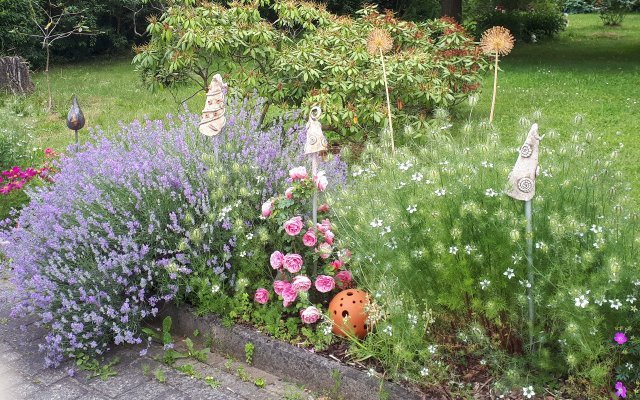
Besides the earwig house, there are many other ways to make your garden insect-friendly. Insect diversity helps create a natural balance in your garden. Insects play an important role in nature. As pollinators for many plants or as food for various animals such as hedgehogs or birds. If you want to support insects, you can offer them a retreat in your garden.
Researchers have found that the number of insects continues to decline. This insect mortality has fatal consequences for animals, plants and not least for us humans. In your garden you have the opportunity to make an active contribution against this by giving insects a home.

